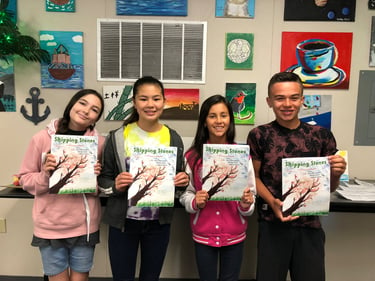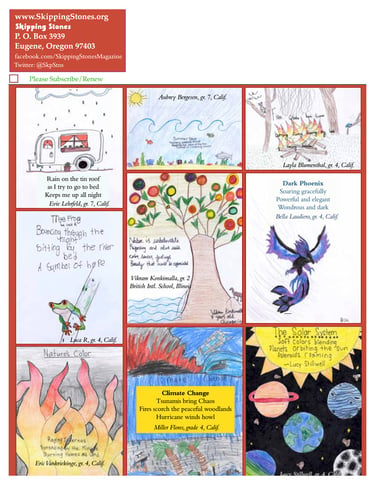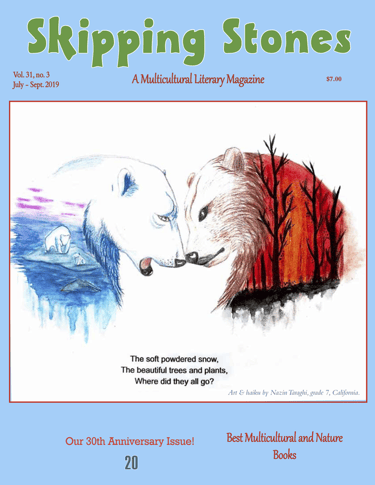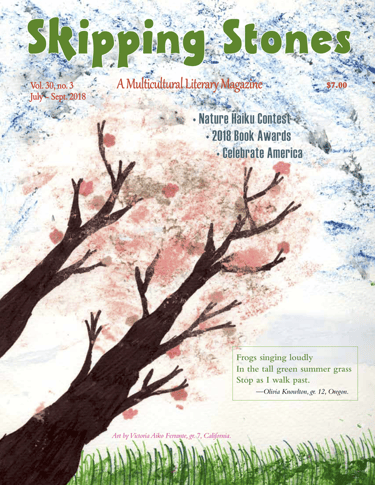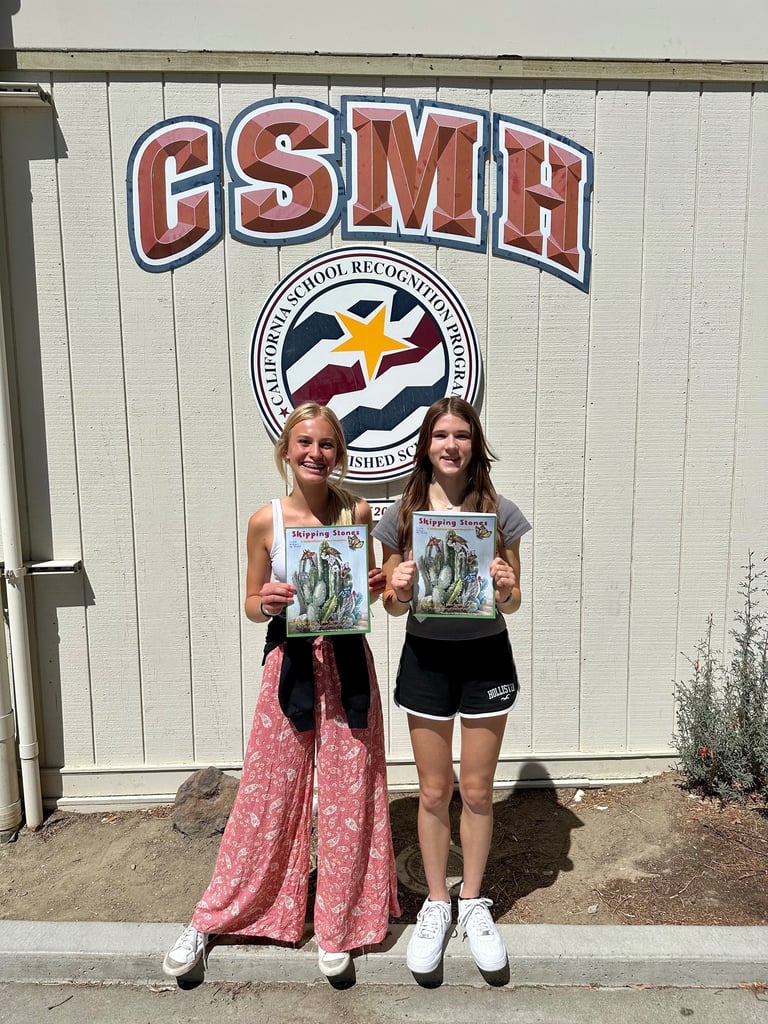In addition to reading and analyzing poems, students will also explore poetry as literary agents. Students will write several original poems, then type and publish them in books for Spring Exhibition. Generally, students will be introduced to a style, form, or theme of poetry on Monday and will work on an original poem throughout the week (typing in class on Friday). Students are also encouraged to write and type original poems outside of school hours. There will likely be multiple opportunities to enter poetry contests, including Skipping Stones Multicultural Literary Magazine. Several CSMH students have been published and/or won cash prizes in the past. Details given in class.
Best Part of Me Poem
Where I am From Poem ― Be creative and end with "Welcome to ME" PDF EXAMPLE
Cinquain (five lines: (1) subject, (2) adjectives, (3) verbs, (4 word) phrase, (1) synonym) PDF
Carpe Diem poem PDF
Vocabulary Poem in the style of Kwame Alexander (see The Crossover)
Judge Not (inspired by the Bob Marley song, and Mr. Tubach's tattoo) PDF
Found Poem (Blackout OR book spines)
Ode in the style of Pablo Neruda (lyrical dedication to something ordinary) PDF, PDF
Epistle Poem (letters in verse, addressed to a passion) PDF
Honest Poem in the style of Rudy Francisco. START THE NEW YEAR WITH SOME HONESTY PDF
Two-voice Poem (collaborative, Joyful Noise, Phoenix, Two Women, Partner Poems) Full, PDF VIDEO VIDEO
Blues poem in the style of Langston Hughes, (rhyming triplets x3 AAA BBB CCC) PDF sketch: blue tear drops
Limerick in the style of Edward Lear (five lines, AABBA, A = 8-9 syllables, B-5-6 syllables) PDF
Haiku (Japanese 5-7-5)
Tanka (Japanese, 5-7-5-7-7, + personification, metaphor & simile) PDF sketch: Japanese characters
Renga (Japanese, collaborative, 5-7-5, 7-7, 5-7-5, 7-7, 5-7-5, 7-7) PDF
Wu-yan-li-shi (5 syllable lines, in the style of Chinese immigrants at Angel island) PDF sketch: Chinese characters
Confessional Poem ("Mirror") in the style of Sylvia Plath PDF
Occasional Poem, with inspiration from "The Hill We Climb" by Amanda Gorman PDF
I've Learned Poem in the style of Omer B. Washington. This is a "list poem" PDF
I Am Poem (self-reflection, descriptive language, patterned, this will be "About the Author" page) PDF sketch: self-portrait
Alliteration: the repetition of the same sounds at the beginning of words.
Couplet: a pair of rhyming lines.
Hyperbole: extreme exaggeration, not to be taken seriously.
Idioms: phrases with special figurative meanings that are different than their literal meanings.
Metaphor: a comparison between two things that are unrelated
Onomatopoeia: a word that phonetically resembles the source of the sound that it describes
Personification: human characteristics given to nonhuman things
Rhyme: similar sounds at the end of words.
Simile: a metaphor that uses "like" or "as"
Stanza: a group of lines within a poem. A stanza is to verse as a paragraph is to prose.
Subject: what a poem is about
Syllables: typically, vowel sounds in a word. Pattern example 5-7-5
Theme: the central idea of a poem
Turn: a change in voice or theme of the poem toward the end
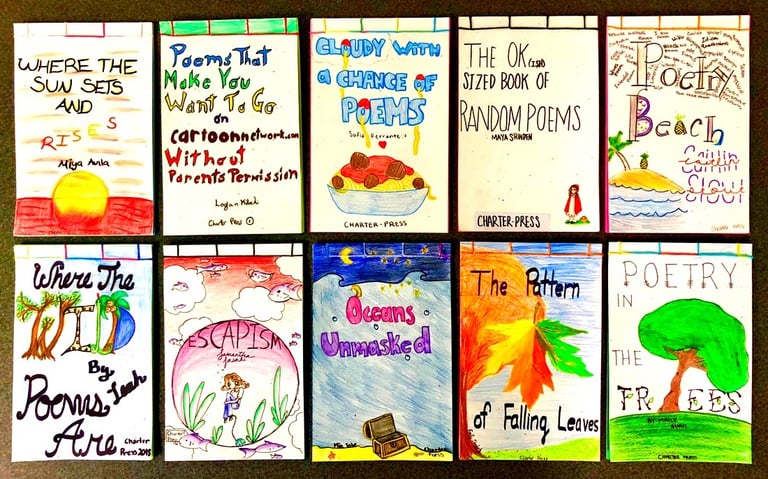


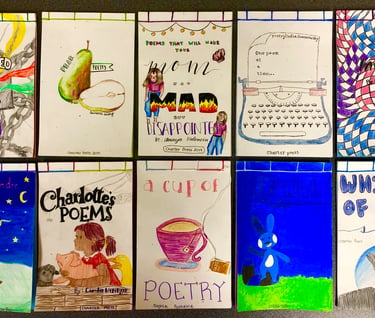
Poetry & Paragraph Writing
Vocabulary
Poetry Books
In April (National Poetry Month) students will print all of the poems they've written throughout the school year and sew them into a book. The books are 5.5" X 8.5" with the binding at the top, for a unique flare. Students will sew their poetry books using an old form of Japanese stab binding called Yotsume Toji (traditional four-hole). If I discover that a student has sewing experience and is willing to try something more complicated, I may allow them to attempt an advanced pattern, in which case it would be necessary to practice at home.
Each book will have a front/back cover, a title page, a copyright page, a dedication page and 20+ original poems. Each poem is on a separate page with a title, explanatory paragraph and the poem itself. Each explanatory paragraph has three parts (1) subject, (2) form/style/theme, (3) inspiration.
